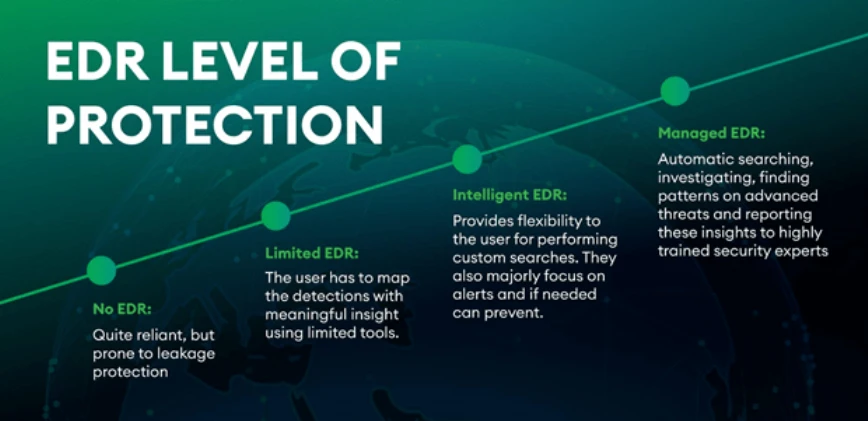What are EDR Solutions?
Endpoint Detection and Response (EDR) solutions are advanced cybersecurity tools designed to detect, investigate, and respond to threats at the endpoint level. Unlike traditional antivirus software, which primarily relies on signature-based detection to identify known malware, EDR solutions leverage behavioral analysis, machine learning, and real-time monitoring to detect suspicious activities that could indicate an ongoing attack. This proactive approach enables organizations to identify and mitigate threats before they can cause significant damage.
EDR solutions work by continuously collecting and analyzing endpoint activity data, providing security teams with deep visibility into potential threats. They monitor processes, file activities, network connections, and user behaviors to identify anomalies that could indicate malicious activity. When a potential threat is detected, EDR tools provide security analysts with detailed forensic data, enabling them to understand the scope of the attack and take appropriate action.
One of the key features of EDR solutions is real-time threat detection. By leveraging behavioral analytics and threat intelligence, EDR tools can identify zero-day threats, ransomware, and advanced persistent threats (APTs) that traditional security solutions may miss. This allows security teams to respond swiftly to contain threats before they spread across the network.
Another critical capability of EDR is automated response and remediation. Many EDR solutions can automatically isolate compromised endpoints, terminate malicious processes, and roll back changes made by malware to minimize the impact of an attack. This automation reduces the time it takes to respond to security incidents, helping organizations prevent widespread damage and data breaches.
EDR solutions also play a crucial role in forensic analysis and incident investigation. Security teams can use EDR logs and recorded endpoint activity to trace the origins of an attack, understand how it unfolded, and determine the extent of the compromise. This information is essential for improving security policies, strengthening defenses, and preventing future incidents.
In addition to standalone deployment, EDR solutions are often integrated with other security tools such as Security Information and Event Management (SIEM) and Extended Detection and Response (XDR) platforms. This integration enhances threat correlation across multiple layers of an organization’s security infrastructure, providing a more comprehensive defense against cyber threats.
As cyber threats continue to evolve, organizations need a proactive approach to endpoint security. EDR solutions provide the visibility, detection, and response capabilities necessary to defend against modern cyberattacks, making them a critical component of any cybersecurity strategy.
Key Features of Endpoint Detection & Response Solutions
Endpoint Detection and Response (EDR) solutions offer a range of advanced security capabilities designed to detect, analyze, and respond to cyber threats in real time. Unlike traditional endpoint protection tools that focus primarily on prevention, EDR solutions provide continuous monitoring and rapid response to threats that bypass initial security layers. Below are the key features that make EDR solutions essential for modern cybersecurity strategies.
One of the most critical features of EDR is real-time threat detection and monitoring. EDR continuously collects and analyzes endpoint activity, searching for suspicious behaviors that indicate potential cyber threats. By leveraging machine learning and behavioral analytics, EDR can identify anomalies such as unauthorized access attempts, unusual process executions, and suspicious file modifications. This real-time monitoring ensures that security teams can quickly detect and respond to threats before they escalate.
Another essential feature is automated response and remediation. When EDR detects a security incident, it can take immediate action to contain the threat. This may include isolating infected endpoints from the network, terminating malicious processes, or rolling back system changes caused by malware. Automation reduces response times and minimizes the impact of an attack, helping organizations maintain business continuity.
Threat intelligence integration is another key component of EDR solutions. Many EDR tools leverage global threat intelligence feeds to stay updated on the latest attack techniques and indicators of compromise (IOCs). This enables security teams to identify known threats faster and apply proactive defense strategies against emerging cyber risks.
Forensic analysis and incident investigation capabilities are also crucial in EDR solutions. EDR continuously logs and stores endpoint activity data, providing security teams with a detailed record of system events. In the event of a security incident, analysts can use this data to trace the attack’s origin, understand its impact, and determine how it spread across the network. This forensic capability helps organizations improve their overall security posture and prevent similar attacks in the future.
EDR solutions also offer advanced threat hunting capabilities, allowing security teams to proactively search for hidden threats within the network. By analyzing historical and real-time data, security analysts can identify indicators of compromise that may have been missed by automated detection tools. This proactive approach strengthens an organization’s ability to prevent sophisticated attacks before they cause harm.
Integration with other security solutions, such as Security Information and Event Management (SIEM) and Extended Detection and Response (XDR) platforms, further enhances the effectiveness of EDR. By correlating threat data across multiple layers of security, organizations can gain a more comprehensive view of their security posture and improve their ability to detect and respond to cyber threats.
Overall, EDR solutions provide a critical layer of security by offering continuous monitoring, automated response, forensic analysis, and advanced threat detection. As cyber threats become more sophisticated, organizations must leverage EDR to stay ahead of attackers and protect their endpoints from evolving security risks.
Key Considerations When Choosing an EDR Solution
When selecting an Endpoint Detection and Response (EDR) solution, organizations must evaluate several critical factors to ensure they choose a platform that effectively detects, analyzes, and mitigates cyber threats. With a growing number of EDR vendors in the market, it’s essential to assess key considerations to align the solution with security needs, compliance requirements, and operational goals.
One of the most important factors to consider is threat detection and response capabilities. The effectiveness of an EDR solution depends on its ability to detect both known and unknown threats in real time. Look for solutions that leverage behavioral analysis, artificial intelligence (AI),and machine learning (ML) to identify sophisticated attacks that traditional signature-based detection methods may miss. The ability to provide automated responses—such as isolating infected endpoints, terminating malicious processes, and rolling back unauthorized changes—can significantly reduce the impact of cyber threats.
Integration with existing security infrastructure is another crucial aspect. An ideal EDR solution should seamlessly integrate with Security Information and Event Management (SIEM) systems, firewalls, threat intelligence platforms, and other cybersecurity tools. Organizations that use Extended Detection and Response (XDR) solutions should also ensure that the EDR platform complements their broader security strategy by providing endpoint-level insights that feed into the larger threat detection ecosystem.
The ease of deployment and management should also be considered, especially for organizations with limited cybersecurity resources. Some EDR solutions require significant configuration and manual tuning, which can be challenging for small IT teams. Cloud-based EDR solutions offer simplified deployment and centralized management, making them a more scalable option for organizations looking to reduce administrative overhead.
Threat hunting and forensic analysis capabilities are also key differentiators. Security teams need deep visibility into endpoint activities to investigate incidents, trace attack origins, and identify patterns of malicious behavior. Look for EDR solutions that provide comprehensive logging, historical data retention, and interactive search capabilities that enable proactive threat hunting and root cause analysis.
Scalability and performance are essential considerations for organizations with a large number of endpoints. The chosen EDR solution should be capable of handling high volumes of data without causing performance degradation on endpoints or network infrastructure. Lightweight agents that operate with minimal system resource consumption ensure that security monitoring does not impact device performance or user productivity.
Another factor to evaluate is compliance and regulatory support. Organizations operating in regulated industries, such as healthcare, finance, or government, must ensure that their EDR solution meets compliance requirements such as HIPAA, GDPR, CMMC, and PCI-DSS. Built-in reporting and audit capabilities can help organizations demonstrate compliance while improving overall security posture.
Finally, cost and total cost of ownership (TCO) should be factored into the decision-making process. While some EDR solutions come with a higher initial investment, they may provide better automation, threat intelligence, and advanced security features that reduce long-term security costs. Organizations should assess pricing models, licensing structures, and any additional costs associated with training, support, or third-party integrations.
Choosing the right EDR solution requires a balance between advanced security capabilities, operational efficiency, and cost-effectiveness. By carefully evaluating detection capabilities, integration options, scalability, compliance support, and total cost of ownership, organizations can select an EDR platform that strengthens their cybersecurity defenses while aligning with their business needs.






